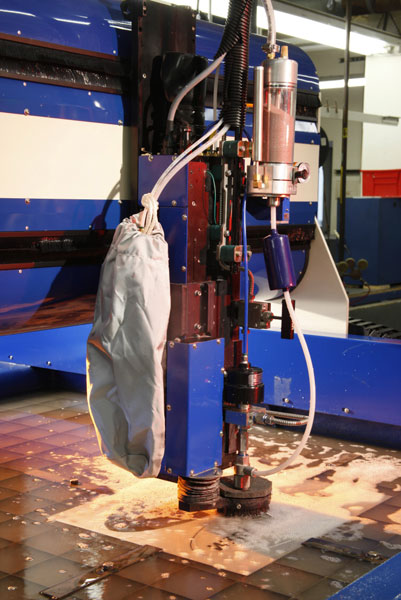At CFW Precision Metal Components, water jet cutting is one of our primary capabilities. We have the technical proficiency to make precise cuts in a variety of materials, including those that are heat-sensitive, delicate, or exceptionally hard. Using powerful software design tools and integrated CAD/CAM technology, we optimize setup and run times for both efficiency and cost savings.
Our water jet cutting services offer advantages over other production methods. Water jets concentrate an extreme amount of energy in a small area to create clean cuts with smooth edges. There is no heat-affected zone to cause thermal distortion or work hardening and the need for secondary machining is reduced or eliminated entirely. Using the very latest programming tools, we can control cutting speed to make intricately detailed cuts in any materials, and these same software tools allow us to create efficient layouts to produce the maximum number of parts from every sheet of material.
Generating up to 50,000 psi cutting force and featuring a 51” x 51” worktable, our water jet cutting equipment cuts 2D shapes in almost any type of sheet material. We process metals of all kinds, from standard grades to hardened steels and high-performance alloys. Using our water jet equipment, we also cut through a wide variety of non-metals, including plastics, ceramics, composites, stone, granite, and many other materials. Maximum sheet thickness varies by the type of material, and in many cases, we can make accurate cuts through multiple layers.
Serving companies in the aerospace, electronics, marine, military, and commercial industries, we can produce cost-effective prototypes using water jet technology and quickly ramp up to production levels of 5,000 units or more. With our ISO 9001 certification, you can be confident in the quality of our products. To learn more about our water jet cutting capabilities, Contact us today.
WATERJET CUTTING SPECIFICATIONS
- General Capabilities
Contract
Prototype
Production
- Characteristics
Minimum Part Stress
No Thermal Distortion or Hardening
Reduced Material Cost Through Nesting
Reduction or Elimination of Secondary Operations
Smooth Finished Edges
- Cutting Axis
2-Axis
- Intended Cutting Material (Metal)
Aluminium
Bonded Material
Boron
Brass
Bronze
Cast Iron
Cobalt
Copper
Exotic Alloys
Hard Facing
Hastelloy
Inconel
Iron
Magnesium
Nickel Alloys
Niobium
Stainless Steel
Steel Alloy
Steel Hardened
Steel Hot Rolled
Steel Mild
Steel Tool
Tantalum
Tin
Titanium
Tungsten
Wrought Iron
Zinc
- Intended Cutting Material (Composites and Plastics)
Acrylic Carbon Fiber
Ceramics
Fiberglass
Foam
Graphite
Kevlar
Linoleum
Mylar Laminates
Neoprene
Nylon
Printed Circuit Board
Plexiglas
Polycarbonate
Polyethylene
Polymers
PVC
Rubber
Silicone
Teflon
Thermoplastics
Urethane
Vinyl
- Cutting Dimensions
Thickness: Depends on application
Width: 51
Length: 51
- Water Jet Pressure
30-50,000 PSI
- Tolerance (+/-)
.01”
- Production Volume
Prototype
Medium Volume (5,000+ Parts)
- Lead Times Available
Standard 35 Days
Quoted on job by job basis
Emergency services available (AOG)
AOG 24 Hour Turnaround
ADDITIONAL INFORMATION
- Industry Focus
Aerospace
Commercial
Electronic
Marine
Military
- Industry Standards
ISO 9001
International Organization for Standardization
- File Formats
AutoCAD (DWG,DWZ)
BMP
Bit Mapped Graphics
Catia (CATDrawing,CATPart)
DXF
Drawing Interchange Format, or Drawing Exchange Format
IGES
Initial Graphics Exchange Specification, ANSI file format.
Inventor (IDW, IPT)
JPG or JEPG
Joint Photographic Experts Group
MasterCam (MDX, MC8, MC9, SET)
PDES
Product Data Exchange using STEP, Standard for the Exchange of Product Model Data. A standard format for exchanging data between advanced CAD and CAM programs.
PDF
Portable Document Format
Pro-E or Pro/Engineer (DRW,PRT,XPR)
SAT
3D ACIS Model File
SolidEdge (DFT)
SolidWorks (SLDPRT,SLDDRW,SLDDRT)
STEP
Standard for the Exchange of Product Model Data

